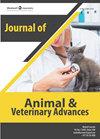Comparison of estrus response and pregnancy rates of beef cows synchronized with progesterone and prostaglandin-based protocols.
引用次数: 4
Abstract
The aim of this study was to compare the estrus response and pregnancy rate between the indigenous beef cows of Malaysia; Kedah-Kelantan (KK) and the exotic beef cows; Brangus (BR) following progesterone and prostaglandin-based estrus synchronization treatments. A total of 40 KK and 30 BR open cows were selected and each breed group was randomly divided equally into two. Cows in KK1 and BR1 were treated with estradiol benzoate (Cidirol, 1 mg, im) each at the time CIDR® was inserted (Day 0). Cloprostenol (Estrumate, 250 μg,im) was administered at the time of CIDR® removal on Day 9 while 1 mg of Estradiol Benzoate (EB) was injected on Day 10. On the other hand, KK2 and BR2 cows received intramuscular injections of 500 and 250 ug of cloprostenol, on Day 0 and 11, respectively. All cows were then observed for estrus signs and scanned per rectum for ovulation followed by AI upon detection of estrus. Pregnancy status was diagnosed 45 days after AI. Both treatments were effective in inducing observable estrus in all groups with synchrony of ovulation resulting in CL development and pregnancy. In the progesterone4)ased treatment groups, 84.2% of KK1 and 78.8% of BR1 responded. In the prostaglandingsed treatment groups, KK2 responded with the highest proportion (80.0%) compared with BR2 (50.0%). However, there was no significant difference in rate of ovulation (84.2 vs. 64.3%; 70.0 vs. 42.9%) and pregnancy (31.6 vs. 14.3%; 45.0 vs. 21.4%) among all the four experimental groups. The interval to ovulation from the last treatment time varied significantly among all the treatment groups with a higher variation observed in BR, ranging from 48 h when treated with CIDR to 84 h after treatment with PGF2α. These variations could be explained by the difference in ovarian status at the time of treatment. In conclusion, the result of this data showed KK cows had a better rate of ovulation and pregnancy than BR cows in both treatments though not statistically significant. It can therefore be gathered that KK and BR responded effectively to estrus synchronization and produce acceptable pregnancy rates by both progesterone and prostaglandn-based protocols for breeding and genetic improvement.以黄体酮和前列腺素为基础的方案同步的肉牛发情反应和妊娠率的比较。
本研究的目的是比较马来西亚本地肉牛的发情反应和怀孕率;吉打吉兰丹(KK)和外来的肉牛;以黄体酮和前列腺素为基础的同步发情治疗后的Brangus (BR)。选取40头KK和30头BR公母牛,每个品种组随机分成2头。KK1和BR1奶牛在CIDR®插入时(第0天)分别注射苯甲酸雌二醇(Cidirol, 1 mg, im),第9天在CIDR®取出时注射氯前列醇(雌二醇,250 μg,im),第10天注射苯甲酸雌二醇(EB) 1 mg。另一方面,KK2和BR2奶牛分别于第0天和第11天肌肉注射500和250 ug氯前列醇。然后观察所有奶牛的发情迹象,并扫描每个直肠是否排卵,在发现发情后进行人工智能。人工智能后45天诊断妊娠情况。两种治疗均能有效地诱导可观察到的发情,并同步排卵导致CL的发展和妊娠。在以黄体酮为基础的治疗组中,84.2%的KK1和78.8%的BR1有反应。在前列腺化治疗组中,KK2的应答比例最高(80.0%),而BR2的应答比例最高(50.0%)。然而,排卵率无显著差异(84.2 vs. 64.3%;70.0 vs. 42.9%)和妊娠(31.6 vs. 14.3%;45.0 vs. 21.4%)。从最后一次治疗时间到排卵的间隔时间在所有治疗组之间差异显著,BR的变化较大,从CIDR治疗的48小时到PGF2α治疗的84小时不等。这些变化可以通过治疗时卵巢状态的差异来解释。综上所述,两种处理下,KK奶牛的排卵率和受孕率均高于BR奶牛,但差异无统计学意义。因此,可以得出结论,KK和BR对发情同步有效,并通过基于黄体酮和前列腺素的育种和遗传改良方案产生可接受的妊娠率。
本文章由计算机程序翻译,如有差异,请以英文原文为准。
求助全文
约1分钟内获得全文
求助全文
来源期刊
自引率
0.00%
发文量
0
审稿时长
1 months
期刊介绍:
Journal of Animal Veterinary advances is a peer-reviewed, open-access scientific journal which publishes articles related to experiments, treatment, analysis, biological elements and other methods of research connected with veterinary. JAVA started publishing activity in 2002, since that time is updated twice a month, and is available in online and print formats. The publications are reviewed by Editorial Board in accordance with the standards and novelty of the subject, while strictly following ethical guidelines. Subject areas suitable for publication include, but are not limited to the following fields :: Veterinary science :: Animal husbandry :: Animal nutrition :: Anatomy :: Biological science :: Pathology :: Infectious diseases :: Animal physiology :: Animal breeding :: Animal biotechnology :: Transgenic animal production :: Animal parasitology :: Veterinary medicine :: Animal feed and nutrition :: Equine.

 求助内容:
求助内容: 应助结果提醒方式:
应助结果提醒方式:


